Effects of Steel Slag and Ethylenediaminetetraacetic Acid (EDTA) on Enhancing the CO2 Sequestration Performance of Gangue-Based Cemented Backfill Materials
Highlights
- Proper steel slag and EDTA improved cemented paste backfill strength and CO2 uptake.
- Strength and CO2 uptake rose then fell with slag/EDTA, optimum at 10% slag, 0.5 g/L EDTA.
- EDTA chelates Ca2+/Mg2+ in steel slag, enhancing ion release and catalyzing carbonation.
- CO2 sequestration consumes hydration products, reducing compressive strength of backfill.
- Synergistic steel slag and EDTA optimize backfill by balancing strength and CO2 uptake.
- The results provide a feasible pathway for the co-utilization of coal-based wastes and steel slag.
- This approach advances green mining and high-value steel slag use.
Abstract
1. Introduction
2. Materials and Methods
2.1. Raw Materials
2.2. Specimen Preparation
2.3. Testing Methods
2.3.1. Compressive Strength
2.3.2. Carbon Sequestration Test
2.3.3. Microstructural Analysis
3. Results
3.1. Compressive Strength
3.2. TG-DTG
3.3. XRD
3.4. SEM-EDS
4. Discussion
4.1. Mechanism of Steel Slag Affecting CPB Properties
4.2. Mechanism of the Synergistic Effect of Steel Slag and EDTA on CPB Properties
5. Conclusions
- (1)
- Compared with the control group, the incorporation of appropriate incorporation of steel slag and EDTA significantly enhanced the compressive strength of the CPB. With increasing steel slag content and EDTA concentration, the compressive strength first increased and then decreased, with the optimal mixture containing 10% steel slag and 0.5 g/L EDTA. Under these conditions, the specimen achieved a compressive strength of 6.4 MPa after 28 d of curing.
- (2)
- The incorporation of steel slag and EDTA also significantly improved the CO2 sequestration performance of the CPB, exhibiting a similar trend to that of compressive strength with an optimal dosage. Under the optimal conditions of 10% steel slag and 0.5 g/L EDTA, the specimen cured for 7 d achieved a CO2 uptake of 7.94%. Moreover, extending the curing age reduced the CO2 uptake, as the value after 28 d of curing was lower than that after 7 d.
- (3)
- The incorporation of steel slag and EDTA affects the performance of cemented backfill materials across the three crucial stages of ion leaching, hydration, and carbonation. Steel slag serves as a source for additional Ca2+ and Mg2+ ions, while the presence of EDTA significantly enhances their leaching and dissolution into the aqueous phase. This synergistic action accelerates the formation of both hydration products and carbonates within the cemented matrix, leading to a stable skeletal structure, improved compressive strength, and enabling long-term CO2 sequestration.
- (4)
- Conversely, when the content of steel slag or the concentration of EDTA is excessively high, a detrimental effect is observed. The resulting surplus of Ca2+ and Mg2+ ions leads to competitive binding with silicate polymers ([SiO4]4−), thereby reducing the formation of hydration products. Furthermore, excessive carbonate precipitates may rapidly form and fully envelop the unreacted particles and existing hydration products, restricting further reaction processes. This ultimately creates porosity and matrix deterioration, leading to a decline in both the material’s compressive strength and carbonation performance.
Author Contributions
Funding
Institutional Review Board Statement
Informed Consent Statement
Data Availability Statement
Conflicts of Interest
Abbreviations
| EDTA | Ethylenediaminetetraacetic Acid |
| CPB | Cemented paste backfill |
| CCUS | Carbon capture, utilization, and storage |
| XRD | X-ray diffraction |
| SEM | Scanning electron microscopy |
| CG | Coal gangue |
| FA | Fly ash |
| OPC | Ordinary Portland cement |
| SS | Steel slag |
| SF | Silica fume |
| XRF | X-ray fluorescence spectroscopy |
| TG | Thermogravimetric |
| DTG | Differential thermogravimetric |
| QXRD | Quantitative X-ray Diffraction |
| CI | crystallinity index |
References
- Zhu, M.; Liu, L.; Wang, S.; Wei, B.; Rong, R.; Zhang, W.; Zhuang, D.; Jia, Q. Backfill-strip mining and CO2 mineralization sequestration in coal mine goaves: A synergetic method and its key technologies. Coal Geol. Explor. 2025, 53, 143–155. [Google Scholar] [CrossRef]
- Zhang, J.; Zhou, N.; Liu, H.; Xie, Y.; Sun, Z.; Ouyang, S. Research progress and prospect of underground utilization of coal-based solid waste functional materials. Coal Sci. Technol. 2025, 53, 1–28. [Google Scholar] [CrossRef]
- Jiao, Y.; Lv, B.; Fan, W.; Li, L.; Wang, M.; Xing, B. Preparation and application prospects of coal-based carbon materials: A comprehensive review. J. Alloys Compd. 2025, 1016, 178951. [Google Scholar] [CrossRef]
- Keskin, T.; Yilmaz, E.; Kasap, T.; Sari, M.; Cao, S. Toward viable industrial solid residual waste recycling: A review of its innovative applications and future perspectives. Minerals 2024, 14, 943. [Google Scholar] [CrossRef]
- Zhang, F. Study on mechanical properties and load-bearing failure characteristics of coal-based solid waste cemented backfill. Coal 2025, 34, 100–104. [Google Scholar] [CrossRef]
- Zhao, H. Experimental Study on Carbon Sequestration Slurry Materials for Goaf Backfilling and Reclamation. Master’s Thesis, China Coal Research Institute, Beijing, China, 2025. [Google Scholar]
- Bordoloi, S.; Afolayan, O.D.; Ng, C.W.W. Feasibility of construction demolition waste for unexplored geotechnical and geo-environmental applications—A review. Constr. Build. Mater. 2022, 356, 129230. [Google Scholar] [CrossRef]
- Krishna, R.S.; Shaikh, F.; Mishra, J.; Lazorenko, G.; Kasprzhitskii, A. Mine tailings-based geopolymers: Properties, applications and industrial prospects. Ceram. Int. 2021, 47, 17826–17843. [Google Scholar] [CrossRef]
- Zajac, M.; Bremeier, R.; Deja, J.; Król, M.; Ben Haha, M. Carbonation hardening of portland cement with recycled supplementary cementitious materials. Cem. Concr. Compos. 2025, 157, 105904. [Google Scholar] [CrossRef]
- Alves, M.O.; Nelson de Goes, L.M.; Simonelli, G. Impact on greenhouse gas emissions in the ammonia production process by reusing heat in the CO2 absorption stage. Energy Convers. Manag. 2026, 347, 120534. [Google Scholar] [CrossRef]
- Saletnik, A.; Saletnik, B.; Puchalski, C. Coal as the world’s dominant energy source and its role in the energy transformation and regulations of european green deal. J. Environ. Manag. 2025, 392, 126815. [Google Scholar] [CrossRef]
- Liu, L.; Fang, Z.; Wang, S.; Gao, G.; Zhang, B.; Zhao, Y.; Zhu, M.; Liu, Z.; Wang, J.; Zhou, J.; et al. Theoretical basis and technical conception of backfill carbon fixation in coal mine. Coal Sci. Technol. 2024, 52, 292–308. [Google Scholar] [CrossRef]
- Kusin, F.M.; Syed Hasan, S.N.M.; Molahid, V.L.M.; Soomro, M.H. Dual adoption opportunities and prospects for mining and industrial waste recovery through an integrated carbon capture, utilization and storage. Sustain. Prod. Consum. 2024, 48, 181–204. [Google Scholar] [CrossRef]
- Zhang, S.; Niu, D.; Luo, D.; Wang, Y. Activation of activator on steel slag-cement and its hydration mechanism. J. Harbin Inst. Tech. 2024, 56, 165–172. [Google Scholar] [CrossRef]
- Biava, G.; Zacco, A.; Zanoletti, A.; Sorrentino, G.P.; Capone, C.; Princigallo, A.; Depero, L.E.; Bontempi, E. Accelerated direct carbonation of steel slag and cement kiln dust: An industrial symbiosis strategy applied in the Bergamo–Brescia area. Materials 2023, 16, 4055. [Google Scholar] [CrossRef]
- Montoya, D.; Pistofidis, N.; Giannakopoulos, G.; Iacobescu, R.; Katsiotis, M.; Pontikes, Y. Revisiting the iron-rich “ordinary portland cement” towards valorisation of wastes: Study of Fe-to-Al ratio on the clinker production and the hydration reaction. Mater. Struct. 2021, 54, 30. [Google Scholar] [CrossRef]
- Wang, X.; Guo, M.; Ling, T. Review on CO2 curing of non-hydraulic calcium silicates cements: Mechanism, carbonation and performance. Cem. Concr. Compos. 2022, 133, 104641. [Google Scholar] [CrossRef]
- Na, H.; Wang, Y.; Zhang, X.; Li, J.; Zeng, Y.; Liu, P. Hydration activity and carbonation characteristics of dicalcium silicate in steel slag: A review. Metals 2021, 11, 1580. [Google Scholar] [CrossRef]
- Song, X.; Zhao, C.; Song, Y.; Guo, Y.; Kong, X. Mineralization curing of steel slag-fly ash solid waste composite alkali-activated cementitious material. Clean Coal Tech. 2024, 30, 88–98. [Google Scholar] [CrossRef]
- Nielsen, P.; Boone, M.A.; Horckmans, L.; Snellings, R.; Quaghebeur, M. Accelerated carbonation of steel slag monoliths at low CO2 pressure—Microstructure and strength development. J. CO2 Util. 2020, 36, 124–134. [Google Scholar] [CrossRef]
- Jhatial, A.A.; Nováková, I.; Gjerløw, E. A review on emerging cementitious materials, reactivity evaluation and treatment methods. Buildings 2023, 13, 526. [Google Scholar] [CrossRef]
- Nunes, V.A.; Borges, P.H.R. Recent advances in the reuse of steel slags and future perspectives as binder and aggregate for alkali-activated materials. Constr. Build. Mater. 2021, 281, 122605. [Google Scholar] [CrossRef]
- Jahami, A.; Issa, C.A. Exploring the use of mixed waste materials (MWM) in concrete for sustainable construction: A review. Constr. Build. Mater. 2023, 398, 132476. [Google Scholar] [CrossRef]
- Zhang, P.; Wang, W.; Zheng, Y.; Hu, S. Effect of recycled aggregate and slag as substitutes for natural aggregate and cement on the properties of concrete: A review. J. Renew. Mater. 2023, 11, 1853–1879. [Google Scholar] [CrossRef]
- Li, W.; Wang, H.; Liu, Z.; Li, N.; Zhao, S.; Hu, S. Steel slag accelerated carbonation curing for high-carbonation precast concrete development. Materials 2024, 17, 2968. [Google Scholar] [CrossRef]
- Rosales, J.; Agrela, F.; Entrenas, J.A.; Cabrera, M. Potential of stainless steel slag waste in manufacturing self-compacting concrete. Materials 2020, 13, 2049. [Google Scholar] [CrossRef]
- Herki, B.M.A.; Ali, A.I.; Smail, Y.S.; Omer, K.M. An innovative approach to enhancing concrete sustainability: Utilising unprocessed steel slag with low CaO and high SiO2 content. Buildings 2025, 15, 1514. [Google Scholar] [CrossRef]
- Gu, X.; Wang, Y.; Sun, D.; Sun, R. Macroscopic and microscopic characteristics of slag-steel slag ce-mentitious system under the action of composite activator. Coal Sci. Technol. 2025, 53, 375–386. [Google Scholar]
- Zhang, X.; Yang, X.; Yang, J.; Yin, S.; Bian, W.; Qi, Y. Development of magnesium slag–steel slag-based composite cementitious material and its backfilling application. Arch. Civ. Mech. Eng. 2025, 25, 194. [Google Scholar] [CrossRef]
- Sunkara, Y.; Vinod, J.S.; Kumari, W.G.P.; Saride, S. Shear behaviour of basic oxygen furnace slag-granulated blast furnace slag mixtures: A laboratory investigation. Constr. Build. Mater. 2025, 494, 143443. [Google Scholar] [CrossRef]
- Yi, G.; Tian, W.; Shi, J.; Guo, J.; Cheng, X. CO2 mineralization curing steel slag-fly ash-portland cement ternary paste: Mechanical properties, microstructure and life cycle assessment. J. Cent. South Univ. 2025, 32, 2487–2510. [Google Scholar] [CrossRef]
- Li, N.; Unluer, C. A comparative study of ethylenediamine tetraacetic acid induced gas-solid and liquid-solid accelerated carbonation for enhancement of steel slag aggregates. Constr. Build. Mater. 2023, 400, 132539. [Google Scholar] [CrossRef]
- Leão, A.; Collin, M.; Ghodkhande, S.; Bouissonnié, A.; Chen, X.; Malin, B.; Liu, Y.; Hovey, G.; Govindhakannan, J.; Plante, E.L.; et al. ZeroCAL: Eliminating carbon dioxide emissions from limestone’s decomposition to decarbonize cement production. Acs Sustain. Chem. Eng. 2024, 12, 15762–15787. [Google Scholar] [CrossRef]
- Jose, V.; Jose, V.; Kuruvilla, E.; Nesaraj, A.S. Fabrication, phytotoxicity, and electrochemical performance of rare-earth metal-based mixed la–ce cobaltite nanospheres: Applications in energy storage and environmental remediation. J. Phys. Chem. Solids 2025, 207, 112935. [Google Scholar] [CrossRef]
- Parhizgar Keradeh, M.; Tabatabaei-Nezhad, S.A. Investigation of the effect of diethylene triamine pentaacetic acid chelating agent as an enhanced oil recovery fluid on wettability alteration of sandstone rocks. Petrol. Explor. Dev. 2023, 50, 675–687. [Google Scholar] [CrossRef]
- Gu, L.; Deng, J.; Yuan, H.; Zhang, X. Effect of ethylenediaminetetraacetic acid and its sodium salt on carbonation performance of steel slag block. Green Bulid. Mater. 2024, 11, 140–145. [Google Scholar]
- Liu, S.; Su, Y.; Yang, M.; Xu, P.; Yi, C.; Nie, Y.; Wang, L. Preparation and activation of slag-blended cementitious materials: A study on the activation of cementitious activity. Met. Mine 2022, 57, 252–258. [Google Scholar] [CrossRef]
- Krevor, S.; de Coninck, H.; Gasda, S.E.; Ghaleigh, N.S.; de Gooyert, V.; Hajibeygi, H.; Juanes, R.; Neufeld, J.; Roberts, J.J.; Swennenhuis, F. Subsurface carbon dioxide and hydrogen storage for a sustainable energy future. Nat. Rev. Earth Environ. 2023, 4, 102–118. [Google Scholar] [CrossRef]
- Librandi, P.; Nielsen, P.; Costa, G.; Snellings, R.; Quaghebeur, M.; Baciocchi, R. Mechanical and environmental properties of carbonated steel slag compacts as a function of mineralogy and CO2 uptake. J CO2 Util. 2019, 33, 201–214. [Google Scholar] [CrossRef]
- Ababneh, A.; Al-Rousan, R.; Gharaibeh, W.; Abu-Dalo, M. Recycling of pre-treated medical waste fly ash in mortar mixtures. J. Mater. Cycles Waste Manag. 2020, 22, 207–220. [Google Scholar] [CrossRef]
- Chen, T.; Xue, Y.; Zhao, X.; Liu, J. Effects of EDTA on the accelerated carbonation behavior of steel slag used as cementitious materials. J. Mater. Cycles Waste Manag. 2023, 25, 1498–1508. [Google Scholar] [CrossRef]
- Katre, S.; Ochonma, P.; Mamidala, A.; Sahu, S.; Nair, A.M.; Ravi, K.; Gadikota, G. Organic ligands and CO2 unlock the potential for energy relevant metals recovery and carbon mineralization from mafic rocks. Sci. Rep. 2025, 15, 10882. [Google Scholar] [CrossRef]
- Thumm, A.K.; Skerencak-Frech, A.; Gaona, X.; Altmaier, M.; Geckeis, H. Uptake of cm (III) and eu (III) by c–s–h phases under saline conditions in presence of EDTA: A batch sorption and TRLFS study. Appl. Geochem. 2024, 170, 106087. [Google Scholar] [CrossRef]
- Zhang, Y.; Shan, J.; Ma, Z.; Liu, Z.; Huang, J.; Fang, Y. Effects of ethylenediaminetetraacetic acid on the properties of accelerated carbonated steel slag as supplementary cementitious materials. Constr. Build. Mater. 2025, 487, 142093. [Google Scholar] [CrossRef]
- GB-T 17671-2021; Test Method of Cement Mortar Strength (ISO Method). National Cement Standardization Technical Committee: Beijing, China, 2021.
- Liu, X.; Wu, P.; Liu, X.; Zhang, Z.; Ai, X. The utilization of carbonated steel slag as a supplementary cementitious material in cement. Materials 2024, 17, 4574. [Google Scholar] [CrossRef]
- Cheng, X.; Tian, W.; Yuan, Q.; Chen, W.; Wan, J.; Guo, J.; Cai, J. Effect of carbon dioxide mineralization curing on mechanical properties and microstructure of portland cement–steel slag–granulated blast furnace slag ternary paste. Constr. Build. Mater. 2024, 431, 136553. [Google Scholar] [CrossRef]
- Zhang, C.; Wang, B.; Li, T.; Wang, Y.; Li, N. High volume steel slag powder-cement alkali excitation characteristics. China Powder Technol. 2023, 29, 55–65. [Google Scholar]
- Wang, X.; Ni, W.; Li, J.; Zhang, S.; Hitch, M.; Pascual, R. Carbonation of steel slag and gypsum for building materials and associated reaction mechanisms. Cem. Concr. Res. 2019, 125, 105893. [Google Scholar] [CrossRef]
- Huo, B.; Zhang, J.; Zhou, N.; Li, M.; Guo, Q. Effect of sodium dodecyl sulfate on CO2 storage and rheological properties of alkali-activated coal gasification slag filling slurry. J. Min. Saf. Eng. 2024, 41, 1279–1288. [Google Scholar]
- Rui, Y.; Qian, C.; Zhang, X.; Ma, Z. Different carbon treatments for steel slag powder and their subsequent effects on properties of cement-based materials. J. Clean. Prod. 2022, 362, 132407. [Google Scholar] [CrossRef]
- Tian, W.; Wan, J.; Cheng, X.; Zhang, J.; Guo, J. Synergistic carbon sequestration performance and microstructure of steel slag-base cementitious materials. J. Build. Mater. 2025, 28, 434–441. [Google Scholar]
- Zhao, J.; Li, Y.; Yang, J.; Cao, X.; Wang, J.; Wang, G.; Sun, L.; Huang, Q.; Cheng, W.; Lyu, Z. Preparation of slag-based foam concrete and its carbon dioxide sequestration performance. Int. J. Greenh. Gas Control. 2024, 135, 104156. [Google Scholar] [CrossRef]
- Ngiwngam, K.; Chinvorarat, S.; Rachtanapun, P.; Auras, R.; Wittaya, T.; Tongdeesoontorn, W. Effect of chemical and steam explosion pulping on the physical and mechanical properties of sugarcane straw pulp trays. Polymers 2023, 15, 3132. [Google Scholar] [CrossRef]
- Saillio, M.; Baroghel-Bouny, V.; Pradelle, S.; Bertin, M.; Vincent, J.; d’Espinose de Lacaillerie, J. Effect of supplementary cementitious materials on carbonation of cement pastes. Cem. Concr. Res. 2021, 142, 106358. [Google Scholar] [CrossRef]
- Han, Y.; Aizenberg, J. Effect of magnesium ions on oriented growth of calcite on carboxylic acid functionalized self-assembled monolayer. J. Am. Chem. Soc. 2003, 125, 4032–4033. [Google Scholar] [CrossRef]
- Li, X.; Mehdizadeh, H.; Ling, T. Environmental, economic and engineering performances of aqueous carbonated steel slag powders as alternative material in cement pastes: Influence of particle size. Sci. Total Environ. 2023, 903, 166210. [Google Scholar] [CrossRef]
- Chen, X.; Zhang, K.; Wang, B.; Wu, Z.; Zhou, M. Design and research on the preparation of pervious concrete using carbonized steel slag as a full component. Buildings 2025, 15, 1526. [Google Scholar] [CrossRef]
- Li, K.; Zhu, L.; Wu, Z.; Wang, X. Properties of cemented filling materials prepared from phosphogypsum-steel slag–blast-furnace slag and its environmental effect. Materials 2024, 17, 3618. [Google Scholar] [CrossRef]
- Wang, J.; Ma, X.; Guo, H.; Wang, H.; Qu, Y.; Jiao, W.; Ma, Z. The influence mechanism of non-free calcium on the dissolution-polymerization reaction of coal gasification ash in alkaline environment. J. Fuel Chemis Tech. 2025, 53, 1416–1426. [Google Scholar] [CrossRef]
- Hao, J.; Zhou, Z.; Chen, Z.; Zhou, Y.; Wang, J. Damage characterization and microscopic mechanism of steel slag-cemented paste backfill under uniaxial compression. Constr. Build. Mater. 2023, 409, 134175. [Google Scholar] [CrossRef]
- Han, J.; Kim, S.; Lee, Y.; Hur, D. Chemical cleaning of magnetite deposits on the flow mini-channels of a printed circuit heat exchanger in an EDTA-based solution. Materials 2022, 15, 1471. [Google Scholar] [CrossRef]
- Deng, J.; Zhang, D.; Gu, L.; Yuan, H.; Zhang, B. Enhanced carbonation of steel slag blocks using various chemical additives. J. Build. Eng. 2025, 105, 112518. [Google Scholar] [CrossRef]
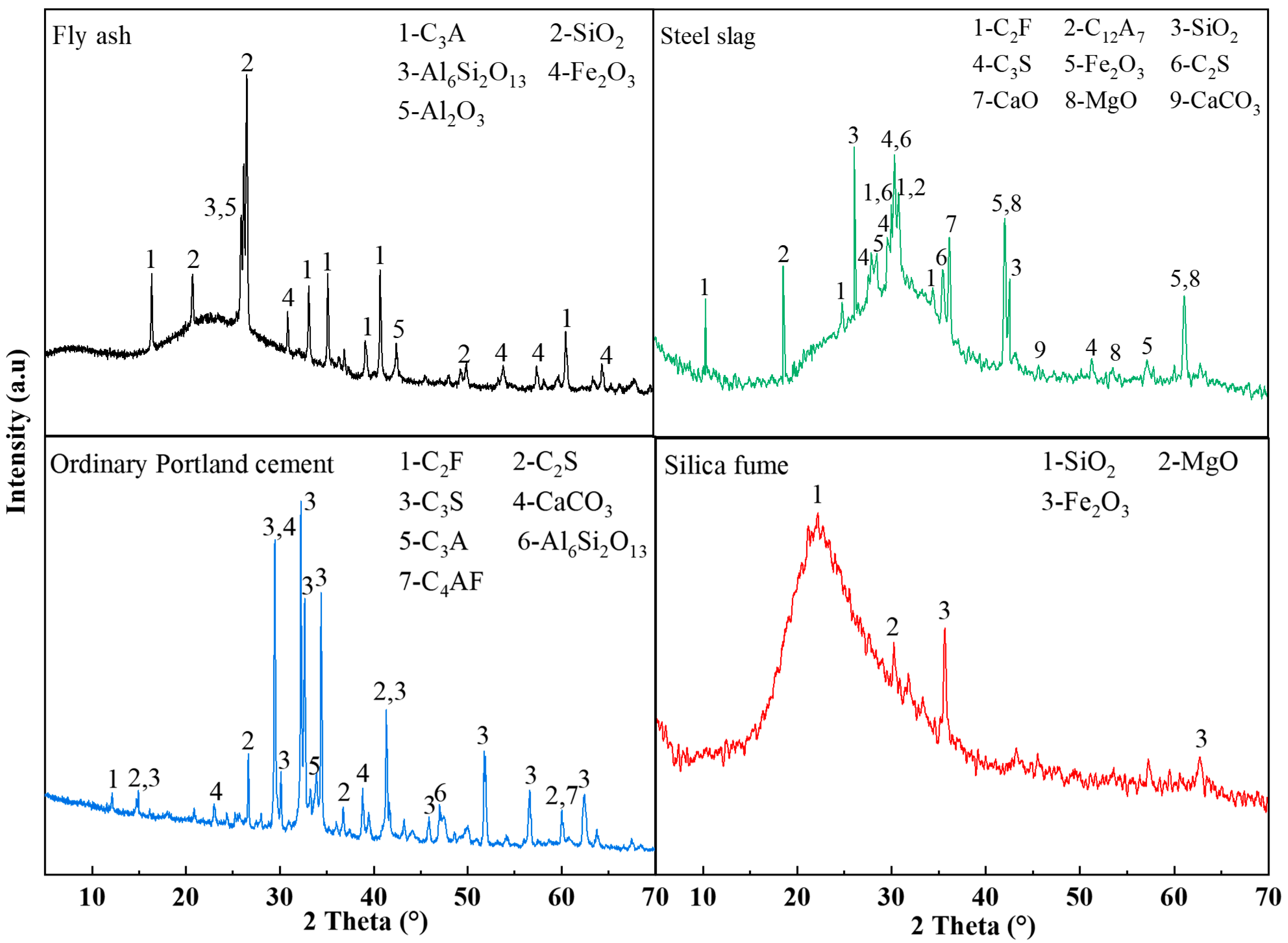
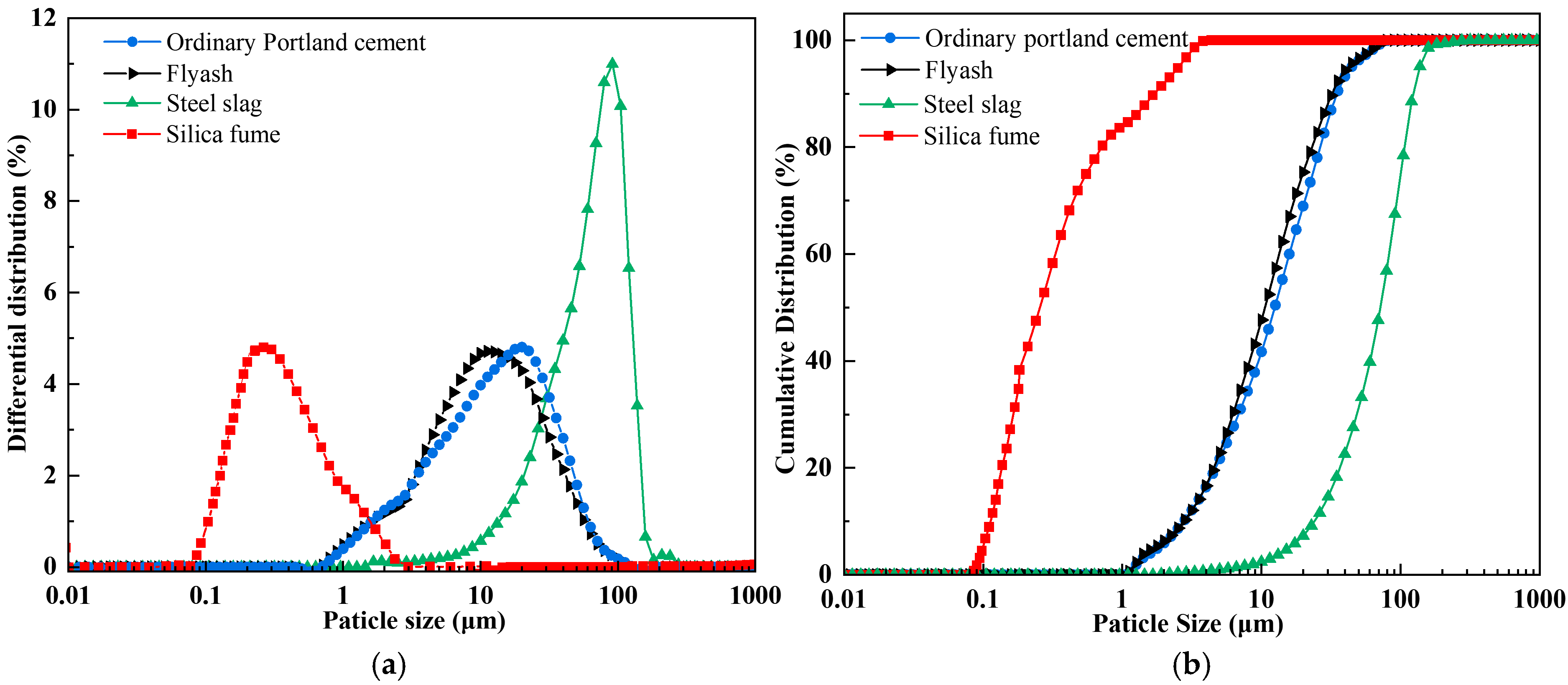
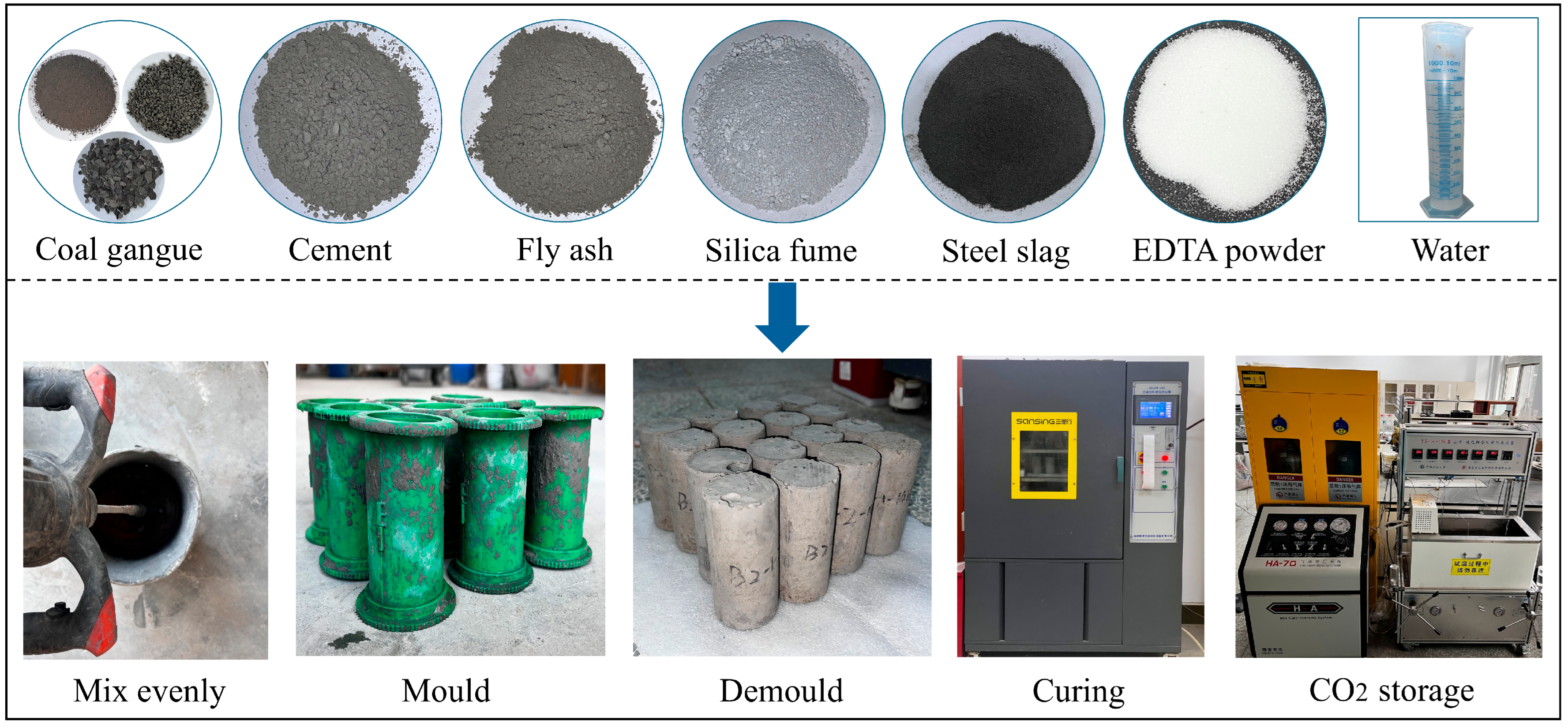
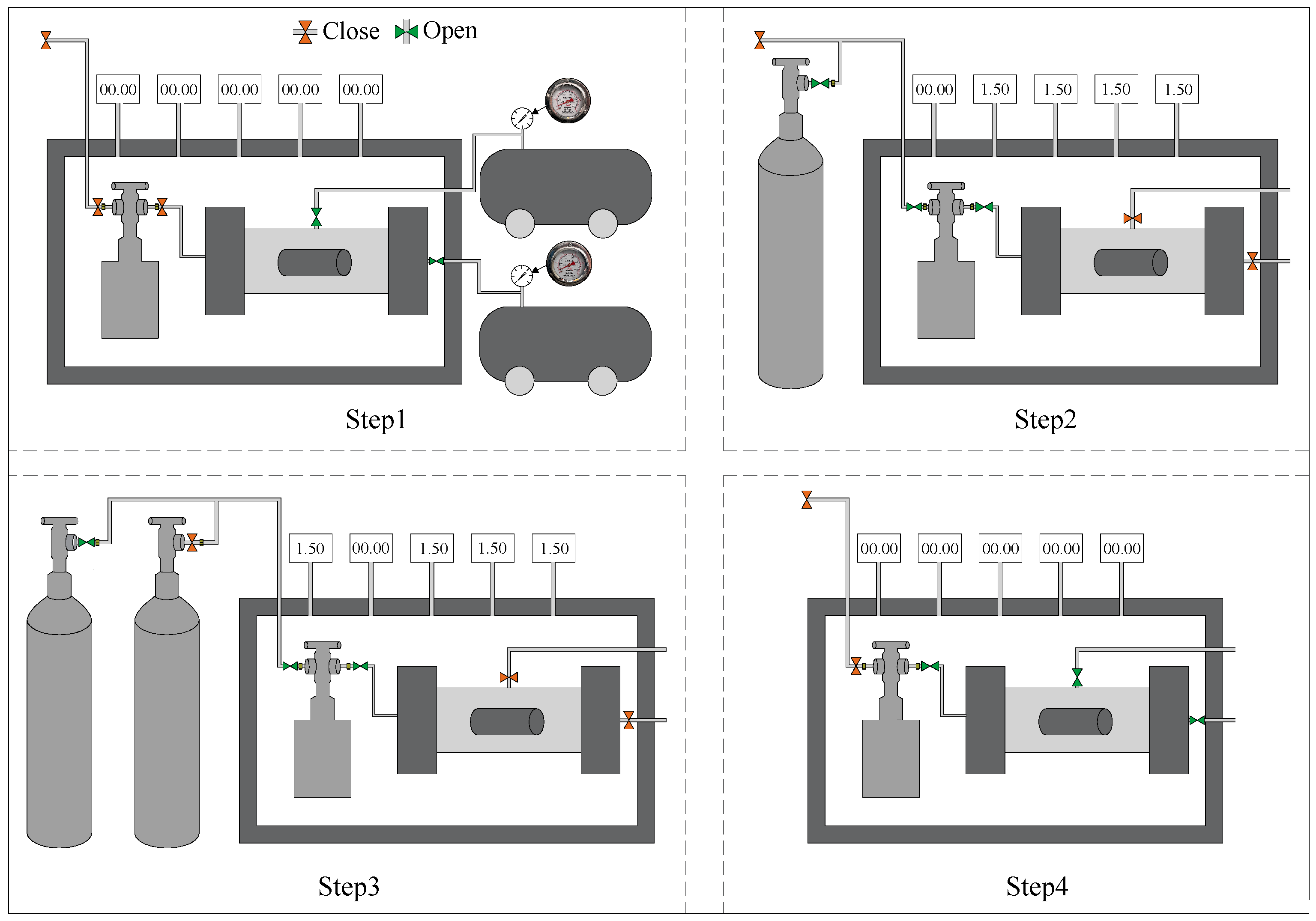
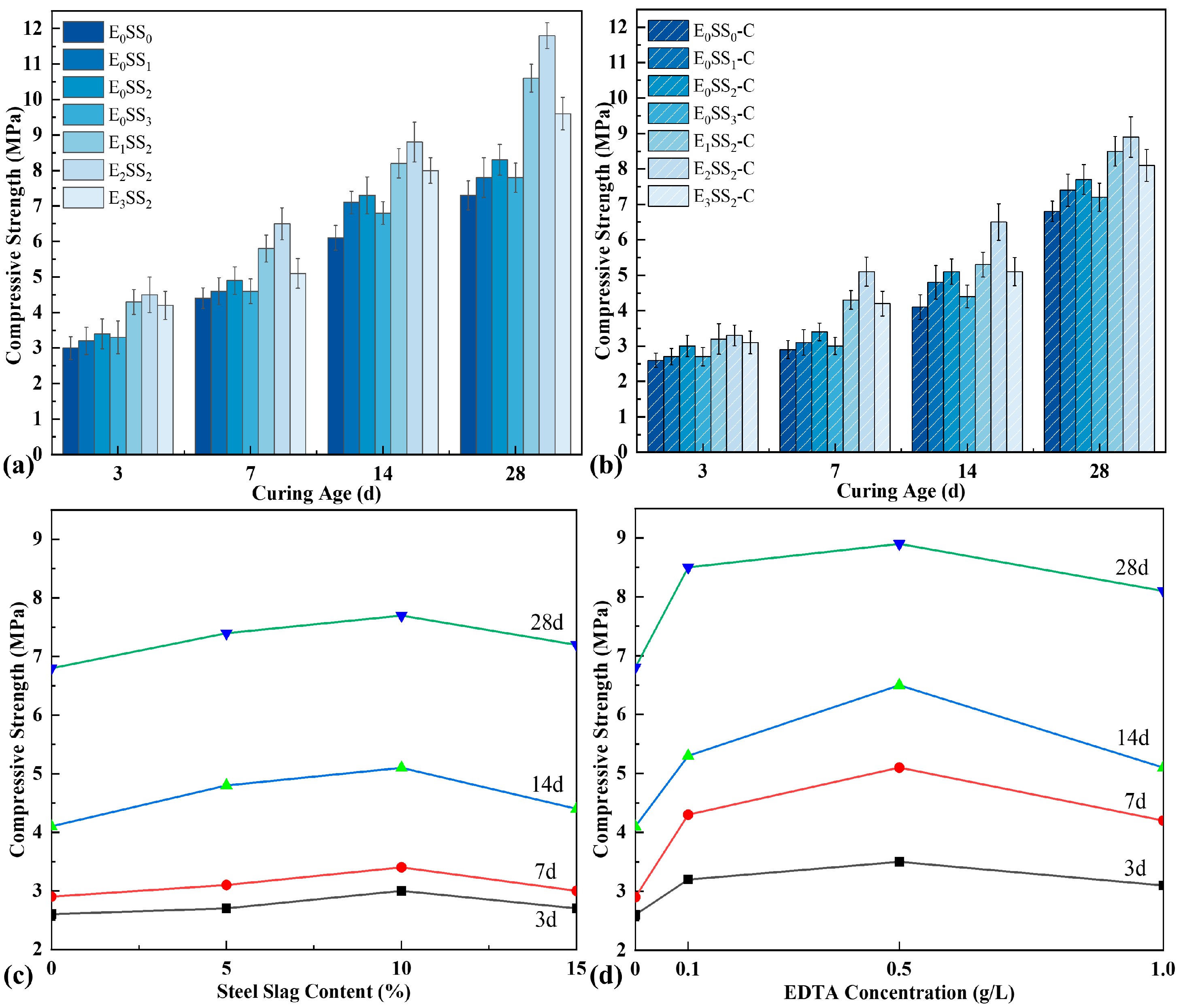
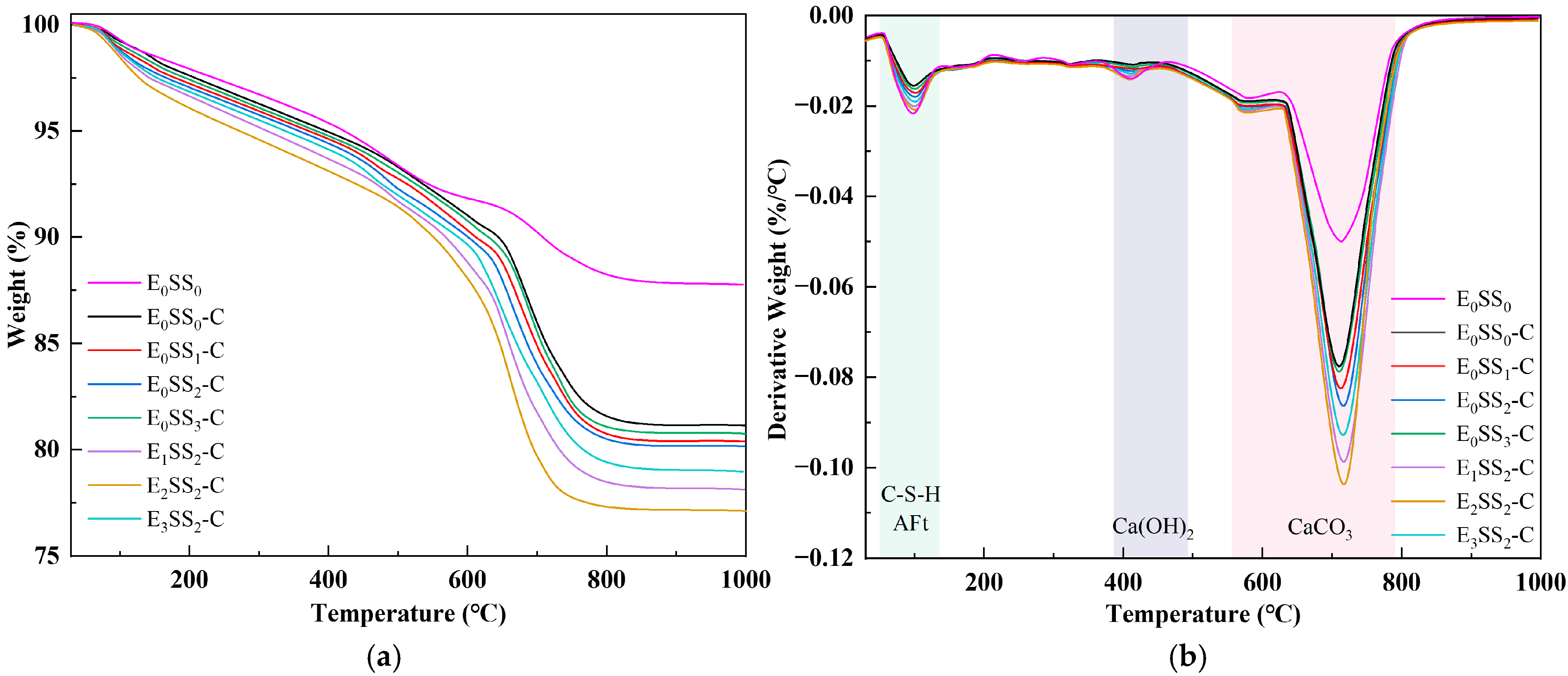
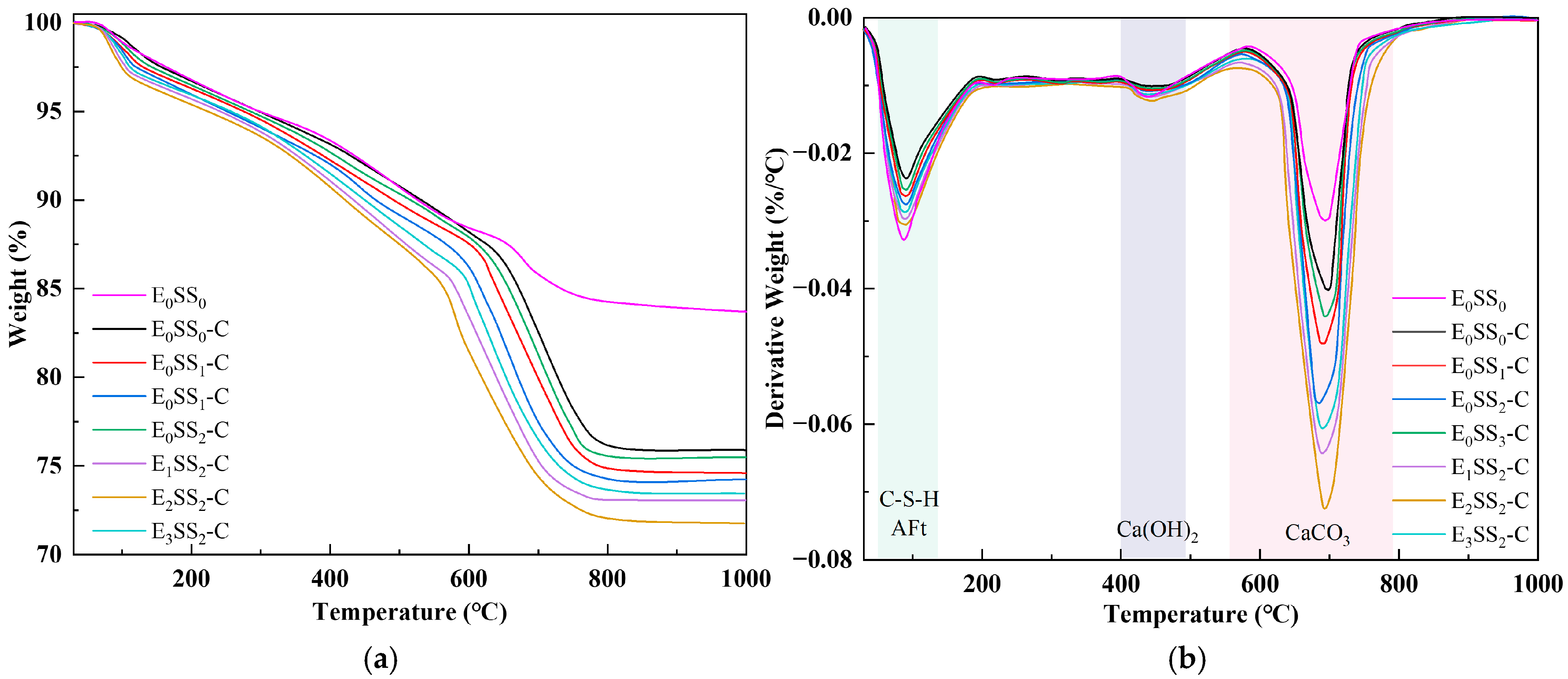

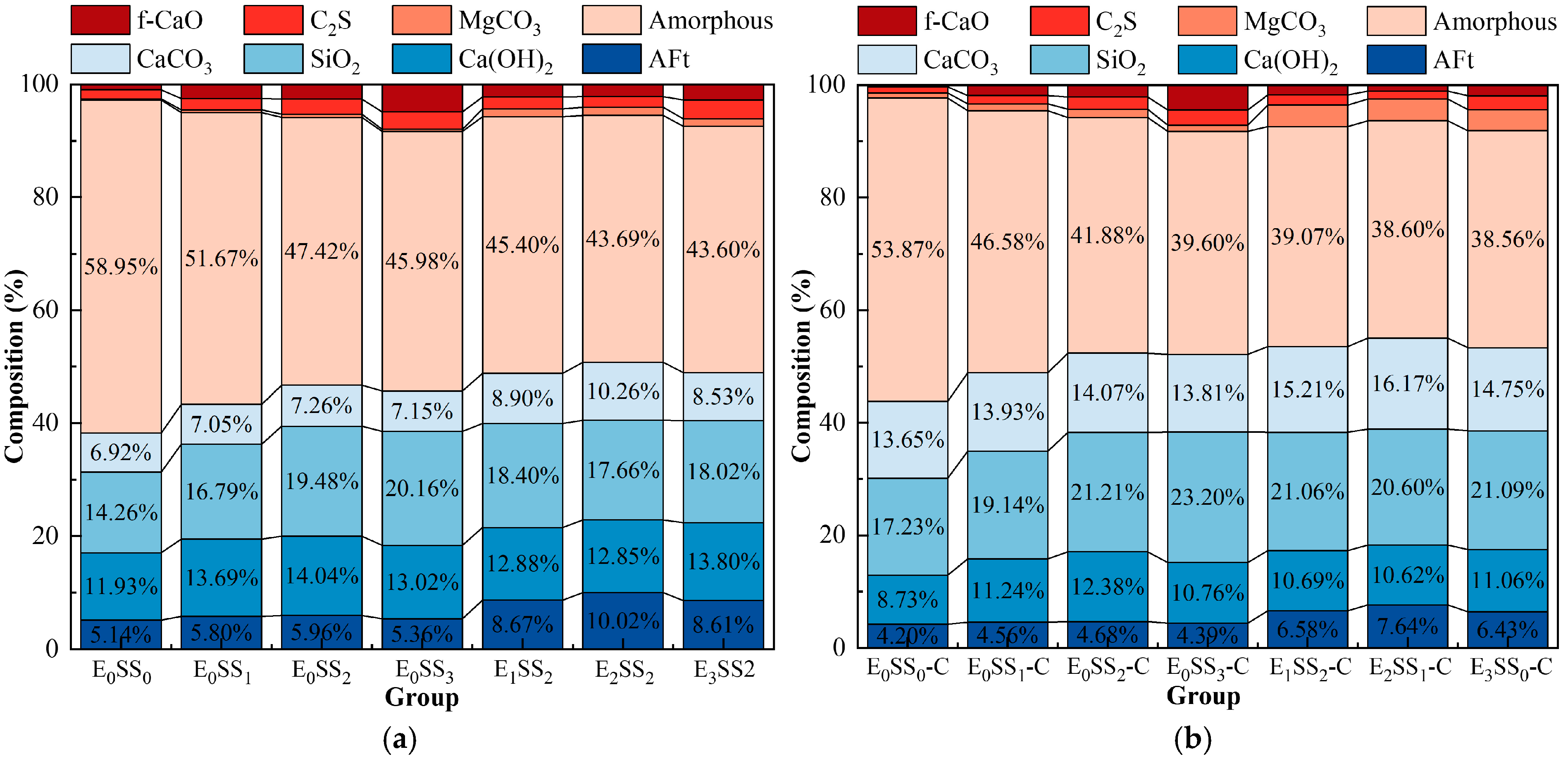
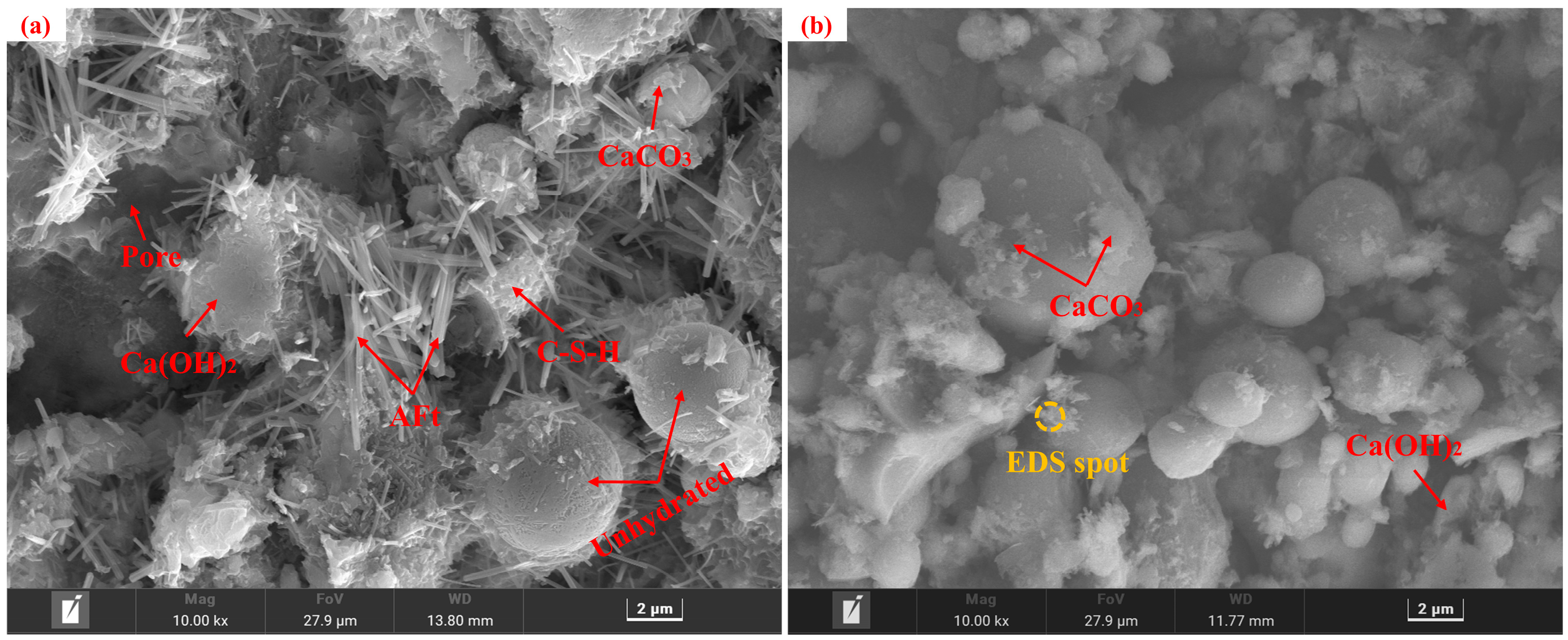
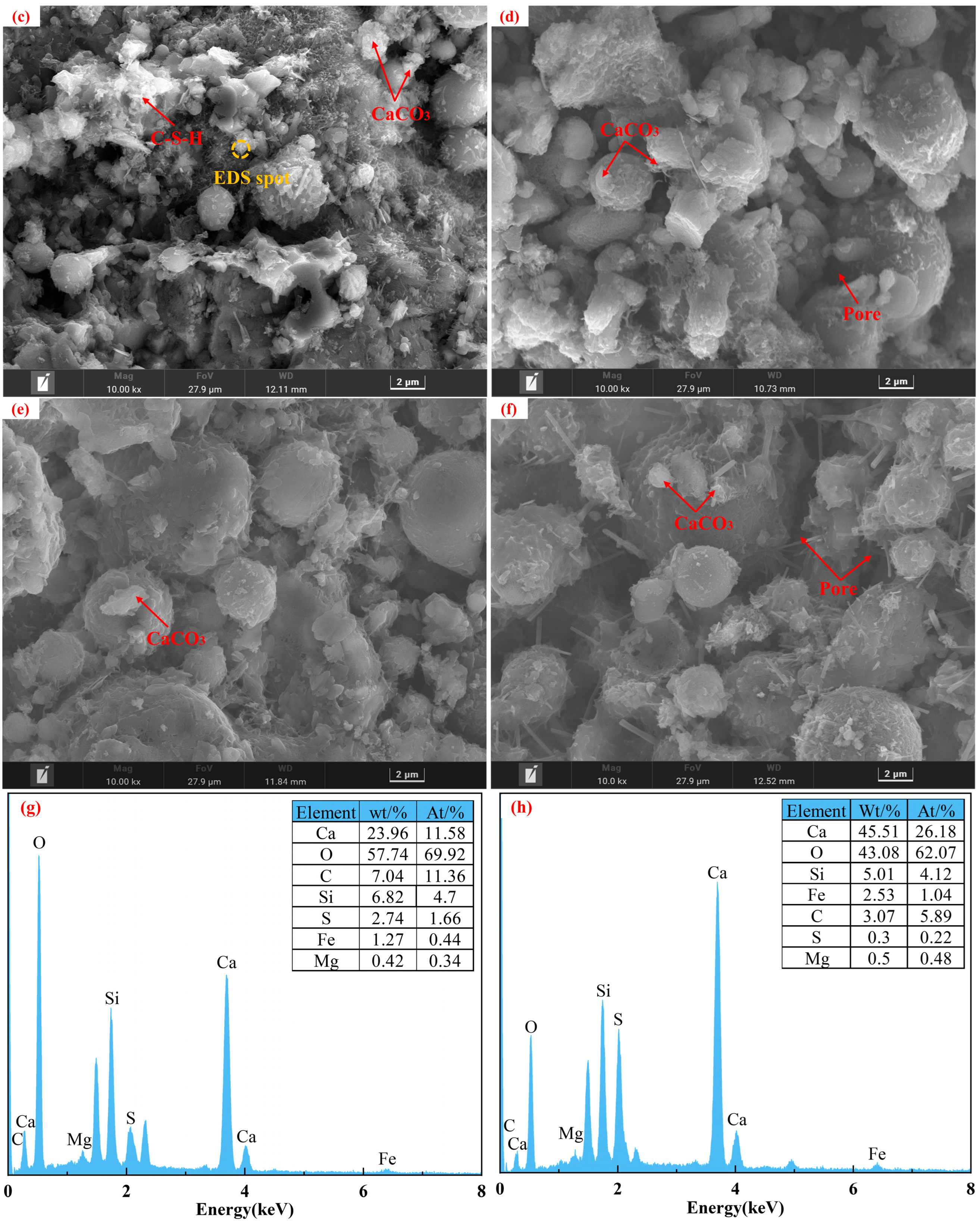


| Materials | CaO (%) | Al2O3 (%) | SiO2 (%) | SO3 (%) | Fe2O3 (%) | P2O5 (%) | MnO (%) | MgO (%) | TiO2 (%) | K2O (%) | Na2O (%) |
|---|---|---|---|---|---|---|---|---|---|---|---|
| FA 1 | 4.50 | 36.80 | 45.10 | 1.20 | 3.90 | / | / | 1.86 | 0.12 | 1.11 | 2.75 |
| SS 2 | 38.72 | 6.37 | 19.40 | 0.81 | 22.42 | 1.38 | 2.10 | 6.05 | 0.88 | / | / |
| OPC 3 | 54.36 | 9.76 | 22.31 | 3.16 | 3.13 | 0.13 | 0.04 | 1.01 | 0.43 | 1.03 | 0.20 |
| SF 4 | 0.62 | 0.53 | 90.27 | 0.36 | 1.66 | 0.07 | / | 2.51 | / | 1.34 | 1.34 |
| Samples | CG 1(%) /(kg/m3) | FA 2(%) /(kg/m3) | OPC 3(%) /(kg/m3) | SF 4(%) /(kg/m3) | Water Binder | EDTA 5 (g/L) | SS 6(%) /(kg/m3) |
|---|---|---|---|---|---|---|---|
| E0SS0 | 60 /1380 | 30 /690 | 7.5 /172.5 | 2.5 /57.5 | 0.5 | / | / |
| E0SS1 | / | 5/115 | |||||
| E0SS2 | / | 10/230 | |||||
| E0SS3 | / | 15/345 | |||||
| E1SS2 | 0.1 | 10/230 | |||||
| E2SS2 | 0.5 | 10/230 | |||||
| E3SS2 | 1.0 | 10/230 |
| Factor | Source of Variation | SS 1 | df 2 | MS 3 | F-Value 4 | p-Value 5 |
|---|---|---|---|---|---|---|
| Steel Slag | Within the group | 1.755 | 3 | 0.585 | 10.74 | 0.002 |
| Between groups | 0.436 | 8 | 0.0545 | |||
| Total | 2.191 | 11 | ||||
| EDTA | Within the group | 20.295 | 3 | 6.765 | 124.1 | <0.0001 |
| Between groups | 0.436 | 8 | 0.545 | |||
| Total | 20.731 | 11 |
| Curing Time (d) | Samples | CO2 Uptake (%) | Estimated Content of CaCO3 (%) |
|---|---|---|---|
| 7 | E0SS0-C | 7.51 | 17.15 |
| E0SS1-C | 7.82 | 17.76 | |
| E0SS2-C | 8.02 | 18.31 | |
| E0SS3-C | 7.77 | 17.75 | |
| E1SS2-C | 8.18 | 18.86 | |
| E2SS2-C | 8.34 | 19.05 | |
| E3SS2-C | 8.07 | 18.43 | |
| 28 | E0SS0-C | 6.01 | 13.65 |
| E0SS1-C | 6.13 | 13.93 | |
| E0SS2-C | 6.19 | 14.07 | |
| E0SS3-C | 6.08 | 13.81 | |
| E1SS2-C | 6.68 | 15.21 | |
| E2SS2-C | 7.09 | 16.17 | |
| E3SS2-C | 6.48 | 14.75 |
Disclaimer/Publisher’s Note: The statements, opinions and data contained in all publications are solely those of the individual author(s) and contributor(s) and not of MDPI and/or the editor(s). MDPI and/or the editor(s) disclaim responsibility for any injury to people or property resulting from any ideas, methods, instructions or products referred to in the content. |
© 2025 by the authors. Licensee MDPI, Basel, Switzerland. This article is an open access article distributed under the terms and conditions of the Creative Commons Attribution (CC BY) license (https://creativecommons.org/licenses/by/4.0/).
Share and Cite
Li, X.; Kang, D.; Li, Z.; Zhou, N.; Chen, Q. Effects of Steel Slag and Ethylenediaminetetraacetic Acid (EDTA) on Enhancing the CO2 Sequestration Performance of Gangue-Based Cemented Backfill Materials. Materials 2025, 18, 4852. https://doi.org/10.3390/ma18214852
Li X, Kang D, Li Z, Zhou N, Chen Q. Effects of Steel Slag and Ethylenediaminetetraacetic Acid (EDTA) on Enhancing the CO2 Sequestration Performance of Gangue-Based Cemented Backfill Materials. Materials. 2025; 18(21):4852. https://doi.org/10.3390/ma18214852
Chicago/Turabian StyleLi, Xinying, Dan Kang, Zejun Li, Nan Zhou, and Qian Chen. 2025. "Effects of Steel Slag and Ethylenediaminetetraacetic Acid (EDTA) on Enhancing the CO2 Sequestration Performance of Gangue-Based Cemented Backfill Materials" Materials 18, no. 21: 4852. https://doi.org/10.3390/ma18214852
APA StyleLi, X., Kang, D., Li, Z., Zhou, N., & Chen, Q. (2025). Effects of Steel Slag and Ethylenediaminetetraacetic Acid (EDTA) on Enhancing the CO2 Sequestration Performance of Gangue-Based Cemented Backfill Materials. Materials, 18(21), 4852. https://doi.org/10.3390/ma18214852







